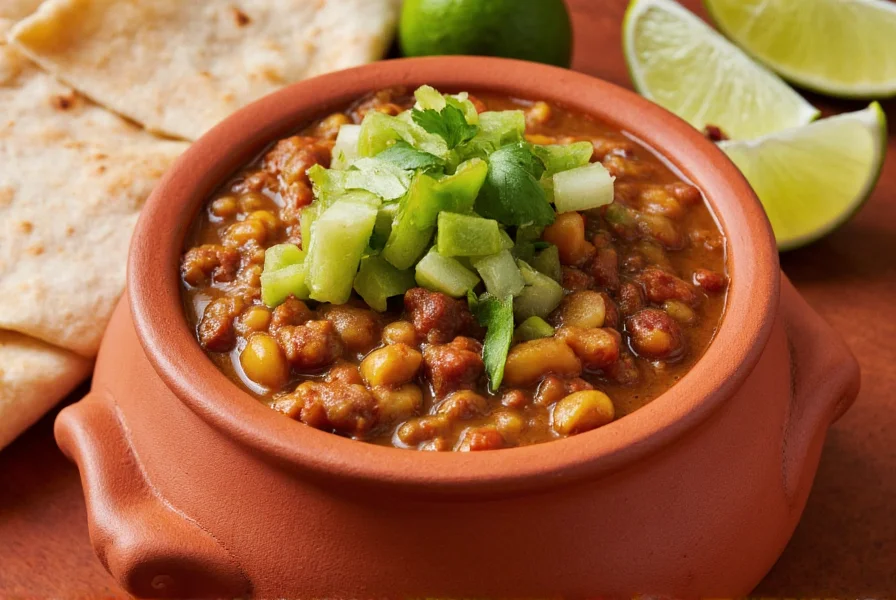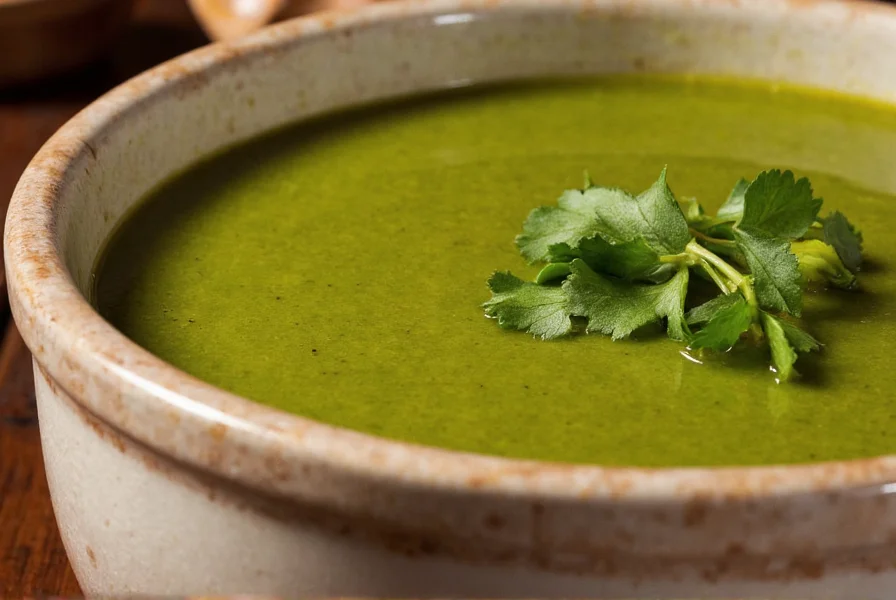When you ask what is chili verde, you're exploring one of Mexico's most beloved comfort foods with deep culinary roots. This vibrant green stew stands apart from its red counterpart through its unique ingredients and preparation method. Understanding what chili verde is made of reveals why it has captivated taste buds for generations across Mexican households and restaurants worldwide.
The Origins of Chili Verde
Chili verde traces its origins to central Mexico, where indigenous communities first combined native ingredients like tomatillos and green chilies. The Aztecs cultivated tomatillos long before Spanish colonization, using them in various sauces and stews. When the Spanish arrived, they introduced meats like pork, which eventually became a staple protein in traditional chili verde recipes.
Unlike red chili made with dried chilies such as ancho or guajillo peppers, chili verde relies on fresh green ingredients that give it a brighter, more acidic profile. This distinction represents one of the fundamental differences between chili verde and green chili preparations you might encounter—authentic chili verde specifically refers to the cooked stew, not just a raw green salsa.
Essential Ingredients in Authentic Chili Verde
The magic of chili verde comes from its relatively simple but carefully balanced ingredients. The foundation consists of:
| Core Ingredient | Function | Common Variations |
|---|---|---|
| Tomatillos | Provides tart base and green color | Must be husked and boiled/roasted |
| Green Chilies | Delivers heat and flavor complexity | Serrano (traditional), jalapeño (milder) |
| Meat | Protein component | Pork shoulder (most traditional), chicken |
| Garlic and Onion | Aromatic foundation | White onion preferred in traditional recipes |
Many people wonder what does chili verde taste like—it offers a complex flavor profile that's simultaneously tangy from the tomatillos, spicy from the chilies, and rich from the slow-cooked meat. The tomatillos provide a citrus-like acidity that distinguishes it from red chili's earthier, sweeter profile.

Traditional Preparation Method
Creating authentic traditional chili verde recipe requires specific preparation techniques that maximize flavor development:
- Prepare the tomatillos: Remove husks, rinse off sticky residue, then boil or roast until they change from bright green to olive green
- Char the chilies: Roast chilies directly over flame or in dry skillet until blistered, then steam in covered bowl before peeling
- Blend the sauce: Combine cooked tomatillos, chilies, garlic, onion, and cilantro in blender until smooth
- Cook the meat: Brown cubed pork shoulder or chicken, then simmer in the blended sauce until tender
- Simmer to perfection: Allow flavors to meld by simmering for 1-2 hours until meat is fork-tender
The key to understanding how to make authentic chili verde lies in properly preparing the tomatillos and chilies. Many novice cooks skip the crucial step of cooking the tomatillos first, which results in a raw, overly acidic flavor rather than the balanced tang characteristic of proper chili verde.
Chili Verde vs Red Chili: Understanding the Differences
One of the most common points of confusion is the difference between chili verde and red chili. While both are Mexican stews, they differ significantly:
- Base ingredients: Chili verde uses fresh tomatillos and green chilies; red chili uses dried red chilies
- Flavor profile: Verde is tangy and bright; red chili is earthy and slightly sweet
- Color: Verde maintains its green hue; red chili has deep reddish-brown color
- Preparation: Verde ingredients are typically boiled or roasted fresh; red chili often involves rehydrating dried chilies
- Regional associations: Verde is more common in central Mexico; red chili has stronger ties to northern Mexico and Texas
Understanding these distinctions helps clarify what is chili verde made of versus other Mexican sauces and stews. It's not simply "green salsa"—chili verde refers specifically to the cooked stew, while salsa verde is the uncooked sauce.
Serving Traditions and Pairings
Knowing the best way to serve chili verde enhances the dining experience. Traditional serving methods include:
- Served hot in deep bowls with warm corn tortillas on the side
- Garnished with fresh cilantro, diced white onion, and lime wedges
- Often accompanied by Mexican rice and refried beans
- Commonly used as a filling for tacos, enchiladas, or burritos
- Sometimes topped with crumbled queso fresco or cotija cheese
In central Mexico, chili verde traditionally appears at family gatherings and celebrations. The dish's comforting nature makes it particularly popular during cooler months, though its bright flavor profile ensures year-round enjoyment.

Regional Variations Across Mexico
While the core concept remains consistent, regional variations of chili verde reflect Mexico's diverse culinary landscape:
- Central Mexico: The birthplace of chili verde, featuring pork as the primary meat with minimal additional ingredients
- Michoacán: Often includes pumpkin seeds for added texture and nuttiness
- Jalisco: May incorporate a touch of chocolate for complexity, similar to mole
- Northern Mexico: Tends to be spicier with more chilies and sometimes includes potatoes
- United States Southwest: Frequently adapts the recipe with available ingredients, sometimes adding cumin or oregano
These regional differences highlight how what is chili verde can vary depending on location while maintaining its essential character. Authentic preparations avoid ingredients like bell peppers or tomatoes, which would alter the distinctive flavor profile.
Storage and Shelf Life Guidelines
Proper storage ensures you can enjoy chili verde beyond the initial preparation. When considering how to store chili verde, follow these guidelines:
- Refrigerate in airtight container for up to 4 days
- Freeze in portion-sized containers for up to 3 months
- Reheat gently on stove (not microwave) to preserve texture
- Flavor often improves after 24 hours as ingredients meld
- Skim excess fat after refrigeration for cleaner flavor
The acidity from the tomatillos helps preserve chili verde better than many other stews, making it an excellent candidate for meal preparation. Many cooks intentionally make larger batches specifically for freezing.
Frequently Asked Questions About Chili Verde
What is the difference between chili verde and salsa verde?
Chili verde refers to a cooked stew typically containing meat simmered in a green sauce, while salsa verde is the uncooked green sauce made from tomatillos and chilies. Salsa verde serves as the base for chili verde but becomes chili verde only after cooking with meat and additional simmering.
Can I make chili verde without meat for a vegetarian version?
Yes, you can create a delicious vegetarian chili verde by omitting the meat and using vegetable broth instead of meat-based stock. Many traditional Mexican cooks prepare vegetarian versions by adding potatoes, zucchini, or mushrooms for texture and substance while maintaining the essential tomatillo-chili base.
Why is my chili verde too sour?
Chili verde should have a pleasant tang from the tomatillos, but excessive sourness usually indicates undercooked tomatillos or an imbalance in ingredients. Properly cooked tomatillos lose some of their raw acidity. If your chili verde is too sour, try simmering longer to mellow the flavors, adding a small amount of sugar, or balancing with a touch of cream or avocado when serving.
What are the most traditional meats used in chili verde?
Pork shoulder (also called pork butt) is the most traditional meat for chili verde in central Mexico, prized for its fat content which enriches the sauce. Chicken, particularly bone-in thighs, is also common and provides a lighter alternative. The meat should be cubed and browned before simmering in the sauce to develop deeper flavors.
How spicy is authentic chili verde supposed to be?
Authentic chili verde ranges from mildly spicy to quite hot depending on the type and quantity of chilies used. Traditional preparations using serrano peppers typically fall in the medium heat range. The heat can be controlled by removing seeds and membranes from the chilies before blending. Unlike some Mexican dishes, chili verde's heat should complement rather than overwhelm the tangy tomatillo flavor.











 浙公网安备
33010002000092号
浙公网安备
33010002000092号 浙B2-20120091-4
浙B2-20120091-4